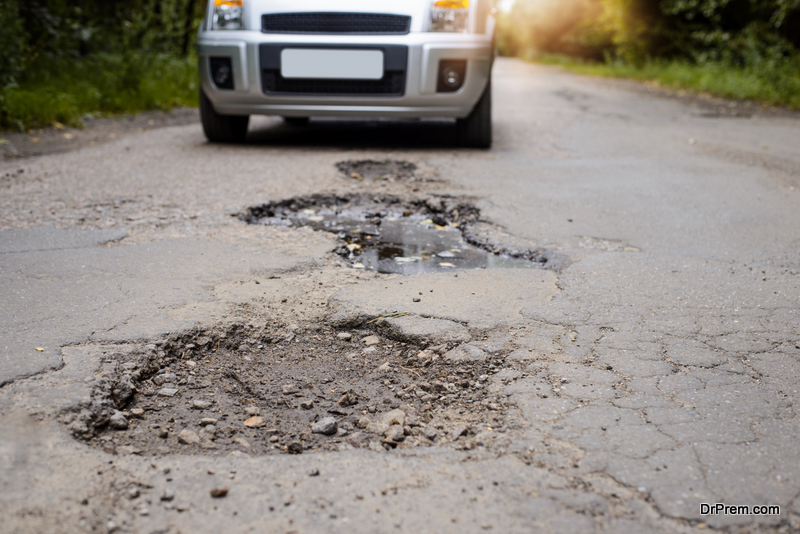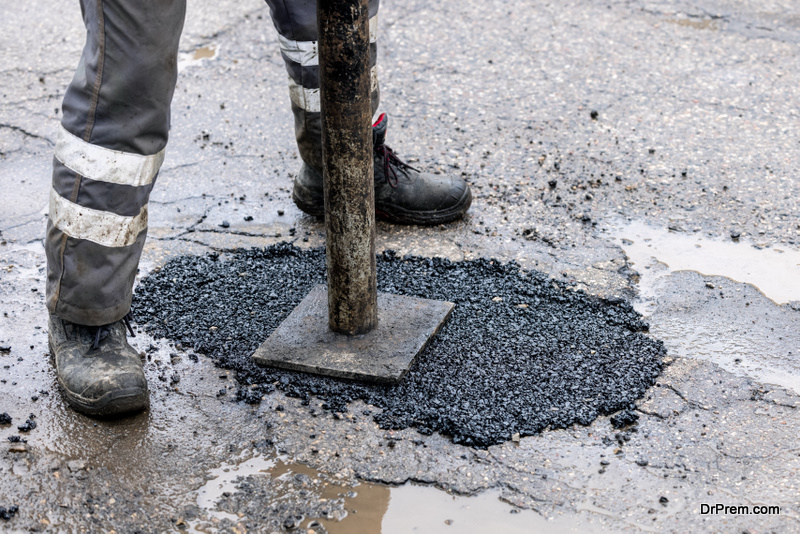Potholes are a common problem on paved surfaces like driveways, parking lots, roads, and sidewalks. They are caused by water seeping into cracks in the pavement and then freeze-thawing, which expands the cracks and causes pieces of pavement to break off. Over time, the weight of traffic can cause the pavement to crumble, leading to the formation of a pothole. Potholes can vary in size, but they typically measure a few inches.
Driveway pothole repair is the process of filling in and smoothing out any depressions or holes that have formed in asphalt or concrete driveways. While small potholes can often be repaired with a simple do-it-yourself kit, larger ones may require the services of a professional contractor. In either case, driveway pothole repair is a relatively simple and inexpensive process that can help to restore the function and appearance of your driveway.
How to identify potholes in your driveway

Potholes can cause damage to your vehicle if you hit them while driving, so it’s important to be able to identify them and take action to repair them. Look for potholes regularly, especially after it rains or snows. Pay attention to any sudden changes in the level of your driveway, as this can be an indication that a pothole has formed. Also, be on the lookout for any cracks or divots in the surface of your driveway, as these can turn into potholes over time.
The best time to repair potholes
The best time to repair potholes is in the spring or summer when the weather is warm and dry. This is because the repair material will need time to cure properly, and high temperatures and low humidity are ideal for this process. However, you can still attempt to repair potholes in the winter, as long as you take steps to protect the repair material from freezing.
How to repair potholes in your driveway
There are two ways of repairing potholes in your driveway. These ways are cold-patch and hot-patch. Now, let’s discuss each of these methods in detail.
Cold-patch pothole repair
The experts from Florida asphalt paving contractor ABC Paving say that this is the most common type of pothole repair. It is a quick and easy process that can be done with a do-it-yourself kit. All you need for this type of repair is a bag of cold-patch mix, which can be found at most hardware stores.
To repair a pothole with cold-patch mix:
1. Clean out the pothole
Use a shovel to remove any loose debris from the pothole, such as dirt, gravel, or leaves. If the sides of the pothole are crumbly, you can use a chisel and hammer to break them off to level with the bottom of the hole.
2. Fill the pothole
Pour the cold-patch mix into the pothole, filling it to just below the level of the surrounding pavement. Use a trowel or your hands to compact the mix as you go.
3. Let it cure
Allow the cold-patch mix to cure for at least 24 hours before driving over it or walking on it.
Hot-patch pothole repair

This method is typically used for larger potholes and is best done by a professional contractor. Hot-patch repair involves heating up asphalt so that it can be poured into the pothole and then compacted. This type of repair is more durable than cold-patch, but it is also more expensive and time-consuming.
Pothole repair tips
- If you’re using a cold-patch mix, be sure to buy only enough for the pothole you’re trying to fill. Unused mix can be stored in a dry, cool place for future use.
- If you’re using hot-patch mix, be sure to wear protective clothing, as the asphalt will be very hot.
- Be sure to compact the repair material as much as possible to ensure a durable repair.
- Allow the repair material to cure for at least 24 hours before driving over it or walking on it.
Common problems with pothole repair
One of the most common problems with pothole repair is that the repair material does not bond well with the surrounding pavement. This can be due to several factors, such as dirt or debris in the pothole or an improper mix of repair material. Another common problem is that the repair material settles too low in the pothole, leaving it vulnerable to being washed out by rain or snow.
To avoid these problems, clean out the pothole thoroughly before filling it, and use only high-quality repair materials. If you’re unsure about how to properly mix or apply the repair material, it’s best to hire a professional contractor to do the job for you.
Prevention is the best solution – How to avoid potholes in the first place
Follow these tips to prevent potholes from forming in your driveway
- Inspect your driveway regularly – inspect your driveway regularly for any cracks or divots in the surface. These can turn into potholes over time, so it’s best to repair them as soon as possible.
- Fill cracks and divots promptly – use a high-quality crack filler to fill any cracks or divots in your driveway. This will help prevent water from seeping into the cracks and causing further damage.
- Seal your driveway – sealing your driveway will help protect it from the elements and extend its lifespan. Be sure to use a high-quality sealer designed for asphalt driveways.
- Don’t wait to repair potholes – if you find a pothole in your driveway, don’t wait to repair it. The sooner you fix it, the less damage it will cause to your driveway.
Potholes are an unfortunate reality of owning a home. But with a little preventive maintenance and prompt repairs, you can keep them from becoming a big problem.
Article Submitted By Community Writer




